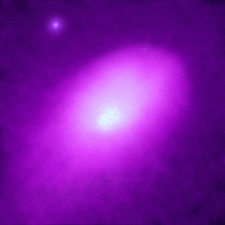March 1, 2000
CXC PR: 00-08
A colossal cosmic "weather system" produced by the collision of two giant clusters of galaxies has been imaged by NASA's Chandra X-ray Observatory. For the first time, the pressure fronts in the system can be traced in detail, and they show a bright, but relatively cool 50 million degree Celsius central region embedded in large elongated cloud of 70 million degree Celsius gas, all of which is roiling in a faint "atmosphere"of 100 million degree Celsius gas.
"We can compare this to an intergalactic cold front," said Maxim Markevitch of the Harvard-Smithsonian Center for Astrophysics, Cambridge, Mass. and leader of the international team involved in the analysis of the observations. "A major difference is that in this case, cold means 70 million degree Celsius."
The gas clouds are in the core of a galaxy cluster known as Abell 2142. The cluster is six million light years across and contains hundreds of galaxies and enough gas to make a thousand more. It is one of the most massive objects in the universe. Galaxy clusters grow to vast sizes as smaller clusters are pulled inward under the influence of gravity. They collide and merge over the course of billions of years, releasing tremendous amounts of energy that heats the cluster gas to 100 million degrees Celsius.
The Chandra data provides the first detailed look at the late stages of this merger process. Previously, scientists had used the German-US Roentgensatellite to produce a broad brush picture of the cluster. The elongated shape of the bright cloud suggested that two clouds were in the process of coalescing into one, but the details remained unclear. Chandra is able to measure variations of temperature, density, and pressure with unprecedented resolution.
"Now we can begin to understand the physics of these mergers, which are among the most energetic events in the universe," said Markevitch. "The pressure and density maps of the cluster show a sharp boundary that can only exist in the moving environment of a merger."
With this information scientists can make a comparison with computer simulations of cosmic mergers. This comparison, which is in the early stages, shows that this merger has progressed to an advanced stage. Strong shock waves predicted by the theory for the initial collision of clusters are not observed. It appears likely that these sub-clusters have collided two or three times in a billion years or more, and have nearly completed their merger.
The observations were made on August 20, 1999 using the Advanced CCD Imaging Spectrometer (ACIS). The team involved scientists from Harvard-Smithsonian; the Massachusetts Institute of Technology, Cambridge; NASA's Marshall Space Flight Center, Huntsville, Ala.; the University of Hawaii, Honolulu; the University of Birmingham, U.K.; the University of Wollongong, Australia; the Space Research Organization Netherlands; the University of Rome, Italy; and the Russian Academy of Sciences. The results will be published in an upcoming issue of the Astrophysical Journal.
The ACIS instrument was built for NASA by the Massachusetts Institute of Technology, Cambridge, and Pennsylvania State University, University Park. NASA's Marshall Space Flight Center in Huntsville, Ala., manages the Chandra program. TRW, Inc., Redondo Beach, Calif., is the prime contractor for the spacecraft. The Smithsonian's Chandra X-ray Center controls science and flight operations from Cambridge, Mass.
For images connected to this release, and to follow Chandra's progress, visit the Chandra site at:
High resolution digital versions of the X-ray image (JPG, 300 dpi TIFF) are available at the Internet sites listed above. This image will be available on NASA Video File which airs at noon, 3:00 p.m., 6:00 p.m., 9:00 p.m. and midnight Eastern Time. NASA Television is available on GE-2, transponder 9C at 85 degrees West longitude, with vertical polarization. Frequency is on 3880.0 megahertz, with audio on 6.8 megahertz.
MEDIA CONTACTS
Steve Roy
Marshall Space Flight Center, Huntsville, AL
Phone: 256-544-6535
http://www.nasa.gov/centers/marshall/news
Dr. Wallace Tucker
Chandra X-ray Observatory Center
Harvard-Smithsonian Center for Astrophysics, Cambridge, MA
Phone: 617-496-7998



